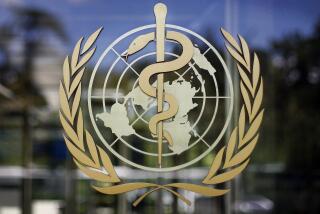Swine flu cases rise to 91 in U.S. with one death
As the swine flu outbreak continued to spread to countries around the world, the World Health Organization on Wednesday took the unprecedented step of raising the infectious disease alert level to phase 5, setting the stage for increased efforts to combat the infection.
The virus “must be taken seriously because of its ability to spread to every country in the world,” WHO Director-General Dr. Margaret Chan said at a news conference in Geneva.
The raised level, triggered by the wide outbreaks in the U.S. and Mexico, means that “all countries should immediately activate their pandemic preparedness plans, and remain on high alert for unusual outbreaks,” she said.
Phase 5 is considered a situation in which the likelihood of a pandemic “is very high or inevitable,” said Dr. Keiji Fukuda, an assistant director-general.
A pandemic is a disease outbreak occurring over a very wide area, crossing international boundaries and usually affecting large numbers of people. That does not necessarily mean it is lethal.
Chan noted that because of planning triggered by the SARS outbreak in 2003 and the potential emergence of bird flu a year later, the world is better prepared for an epidemic. “For the first time in history, we can check the evolution of a pandemic in real time,” she said.
The increased level came as the swine flu outbreak in the United States spread to five more states, bringing the total to at least 95 cases. Texas authorities also announced the first U.S. death from the virus, a nearly 2-year-old boy who died in a Houston hospital Monday.
The boy was a Mexican national from Mexico City who had traveled to Matamoros, Mexico, on a commercial flight with his family April 4, then crossed the border to visit relatives in Brownsville, Texas. The boy, who had an unspecified “underlying health condition,” developed flu symptoms shortly after arriving in the United States and was taken to a hospital in Brownsville before being transferred to Houston.
Officials doubt he infected anyone on the flight because his symptoms did not develop until four days later.
Arizona, Massachusetts, Michigan, Maine and Nevada joined the list of states with confirmed cases, bringing the total to 11 states. Texas said its total had climbed to 16 cases; New York has 51; and California has 15.
On Wednesday afternoon, the Marine Corps said a Marine at the Twentynine Palms base had been confirmed to have the virus. About 30 men at the base who have come into contact with him have been quarantined.
Dr. Mark Horton, director of the California Department of Public Health, said there were another 17 probable cases in the state, including four in Riverside County and two in Los Angeles County. He said there had been six hospitalizations in the state, although details were not yet available.
The Centers for Disease Control and Prevention reported on its website that “a pattern of more severe illness associated with the virus may be emerging in the United States.”
“We expect to see more cases, more hospitalizations, and, unfortunately, we are likely to see more deaths from the outbreak,” Health and Human Services Secretary Kathleen Sebelius told reporters Wednesday on her first day at work following Senate confirmation Tuesday.
As with all flu strains, experts said, the more people who are infected, the greater the likelihood that some will develop more severe illnesses. At this time, however, there is little to suggest this strain will be more virulent than strains already in the population.
Worldwide, new cases have been reported in Canada, Germany, Britain, Austria, New Zealand and Peru, among other countries.
“It’s clear that the virus is spreading, and we don’t see any evidence of it slowing down at this point,” Fukuda said in Geneva.
“The illness we are seeing is generally consistent with seasonal influenza infection,” he added, but there is “a suggestion that cases are developing diarrhea more often.”
He also added that “the epidemiologic information to date more strongly suggests that we are dealing with a virus that is being transmitted from person to person. It is this transmission and travel that are accounting for the cases.”
Mexican health officials said Wednesday that the number of confirmed cases from swine flu had risen to 99. The virus is suspected in 176 deaths.
Mexican President Felipe Calderon went on national TV late Wednesday and said Mexico was suspending all nonessential government services and private businesses for five days, beginning Friday, the start of a long holiday weekend. Calderon urged Mexicans to stay home through Tuesday, which is a holiday when schools will be closed anyway.
Earlier, Mexico City Mayor Marcelo Ebrard told reporters that the number of new flu cases in the city appeared to be leveling off, though he did not cite figures.
The city’s health secretary, Armando Ahued Ortega, said one person had died of swine flu during the previous 24 hours in Mexico City, the country’s hardest-hit spot.
Ebrard said confirmation that the crisis was stabilizing would allow him to consider loosening restrictions on public gatherings, including new rules that limited restaurants to serving only takeout food. Cinemas, museums, concert halls and other public places have closed their doors as part of the effort to prevent infection.
In light of the outbreak, France on Wednesday called on the European Union to ban flights to Mexico. Cuba and Argentina already have done so. A representative of the union’s executive commission said that although individual countries in Europe had the power to take such action, the union itself did not.
Ecuador Health Minister Caroline Chang also barred charter flights to and from Mexico and said the country would restrict entry of passengers from Mexico. Germany’s Lufthansa said it would put a doctor aboard all flights to Mexico to ease passenger’s fears.
Because of an increasing scarcity of passengers, some airlines have sharply reduced fares on flights to Mexico, some by as much as 50%.
Fukuda said that genetic analysis of the new virus indicated that it was originally a swine influenza virus “but is now behaving more or less like a human influenza virus.” Reflecting that change -- as well as pressure from the pork industry -- many officials have begun referring to the virus as the H1N1 virus. European officials prefer to call it “novel flu.”
“There is no evidence that people are getting infected from pigs or that it is dangerous to eat pork,” Fukuda said.
Nonetheless, the Egyptian government Wednesday ordered the slaughter of 300,000 pigs in the country as a protective measure. Muslims in the country do not eat pork, but the animals are raised for the Christian minority.
Dr. Richard E. Besser, acting head of the Centers for Disease Control and Prevention, said New York and Indiana had received their complete allotments of antiviral drugs and all states would have their doses by Sunday.
--
Noam Levey and Mark Silva in Washington, Kimi Yoshino in Los Angeles and Ken Ellingwood in Mexico City contributed to this report.
More to Read
Sign up for Essential California
The most important California stories and recommendations in your inbox every morning.
You may occasionally receive promotional content from the Los Angeles Times.










